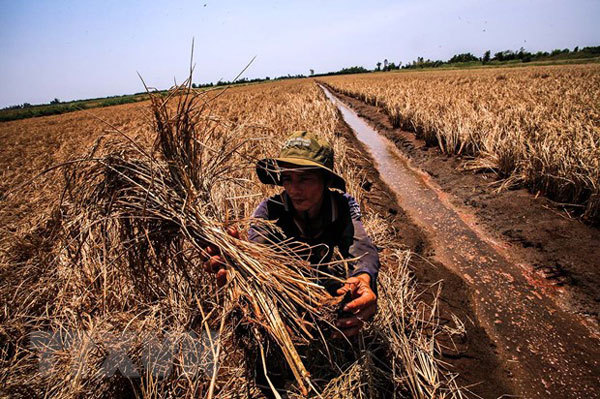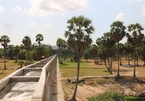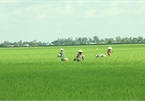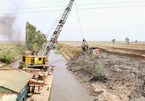 |
| Salinity intrusion destroyed rice fields in the Mekong Delta province of Kien Giang in 2016.—VNA/VNS Photo Trong Dat |
That is more severe than 2016, the year of historic salinity which caused VND15 trillion (US$ 646 million) damage to the delta.
The concentration of salinity was about four grammes per litre, said minister of Agriculture and Rural Development Nguyen Xuan Cuong at a meeting held on Friday in the Mekong Delta province of Ben Tre.
The meeting, chaired by Deputy Prime Minister Trinh Dinh Dung, was organised to direct localities to prevent drought and salinity intrusion during the dry season and ensure agricultural production and livelihoods for local residents.
Cuong said the salinity intrusion in the dry season came sooner than previous years.
Data from the ministry shows saltwater intrusion occurred since the middle of December 2019 in Ham Luong River’s estuary with the concentration of four grammes per litre. The salinity intrusion has covered 57km from the estuary, 17 km deeper than 2016.
As usual, saltwater intrusion often occurred after Tet (Lunar) New Year.
Calculations by Vietnam Academy for Water Resources forecast the salinity intrusion will reach 100km in Vam Co Dong River, about 40km deeper than the annual average and three kilometres deeper than 2016. For Vam Co Tay River, the salinity intrusion will reach 110km, about 52km deeper than the annual average and 5km deeper than 2016.
The salinity intrusion will enter Cai Lon River, reaching 70km, about 30km deeper than the annual average, five deeper than 2016. It will enter other local rivers in the delta, reaching about 55-80km from the rivers’ estuaries, about 23-49km deeper than the annual average and 3-7km deeper than 2016.
Cuong said it would significantly affect agricultural production in many localities.
According to the ministry, the salinity intrusion would affect 10 of 13 provinces in the region.
The ministry predicted about 136,00 ha of fruit trees would suffer while 158,000 households would face a lack of clean water, especially 36,800 households in Ben Tre Province, 32,400 households in Long An Province and 24,400 households in Soc Trang Province.
In response, Cuong said the ministry had directed localities to start the winter-spring crop about a month earlier than normal, to avoid the peak of salinity intrusion.
Pham Anh Tuan, vice chairman of the People’s Committee of Tien Giang Province said the province had dredged canals and installed pump stations to store freshwater in the canals, actively ensuring water for both daily life and production in the dry season.
Nguyen Huu Lap, vice chairman of the People’s Committee of Ben Tre Province said the province had actively stored freshwater since the middle of 2019 and installed 46 stations to measure the concentration of salinity so that they could make plans to cope.
Deputy Prime Minister Trinh Dinh Dung said the delta played a major role in ensuring food security for the region and the whole country.
He ordered all ministries, localities and each individual to work together to minimise the impact.
Local administration were told to take drastic measures to cope with the salinity intrusion and ensure enough freshwater for both daily life and agricultural production.—VNS

Drought, saltwater intrusion loom in Vietnam's Mekong Delta
The Mekong Delta plans to grow this year’s winter – spring rice crop early since drought and saltwater intrusion are forecast to be severe in the dry season starting at the end of this year.

Mekong Delta may face more serious saline intrusion this dry season
The Mekong Delta may experience sooner and even more serious droughts and saltwater intrusion in the 2019 – 2020 dry season, compared to the situation in 2016 when historic saline intrusion was recorded, an official has said.

Mekong Delta attempts to combat saltwater intrusion
Saltwater intrusion in the Mekong Delta is expected to increase between April 28 and May 6 as the volume of water flowing southward from the Mekong River will decline.
 Saltwater intrusion in the Mekong Delta during the dry season, is forecast to enter local rivers 30-40km deeper than the annual average.
Saltwater intrusion in the Mekong Delta during the dry season, is forecast to enter local rivers 30-40km deeper than the annual average.